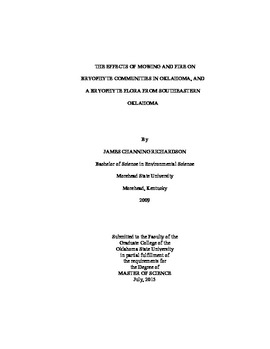| dc.description.abstract | This thesis is composed of four chapters, exploring the effects of mowing and fire on bryophyte communities in Oklahoma and providing a bryophyte flora from southeastern Oklahoma. First, I addressed whether mowing frequency and seasonality affect bryophyte communities within a C4-dominated grassland. All plots were mown under all combinations of the months March, June, September, and unmown for the previous 12 years. Bryophyte cover by species was visually estimated in early 2010. Bryophytes were absent from all unmown plots and present with low cover in all mowed plots. Season of mowing significantly affected bryophyte cover and composition, with the lowest cover in June-only mowings. I conclude that mowing regime has significant and subtle effects on bryophyte communities, even in a relatively xeric, C4-dominated grassland. Second, I ask the question: will epiphytic bryophytes in frequently disturbed areas have a high resilience to fire in terms of cover, species composition, and species richness? To address this question, I sampled bryophytes on three tree species (Acer rubrum, Quercus alba, and Q. rubra) at two study sites located within the Homer L. Johnston Wildlife Management Area in the Ouachita National Forest, LeFlore County, Oklahoma, prior to and following a 2012 prescribed fire. The majority of bryophytes present before the fire suffered extensive or mortal damage from the fire but the species richness of bryophytes did not significantly change. Species composition of epiphyte communities was more affected by phorophyte host species than by the effects of time since fire. These results suggest weakly that bryophytes are not particularly resilient to fire. Third, I provide a bryophyte flora of a 6047 ha portion of the Homer L. Johnston Wildlife Management Area in the Ouachita National Forest. I made collections of bryophytes from spring 2012 to early spring 2014. I found 50 families and 74 genera represented by 87 moss, one hornwort, and 29 liverwort species. This includes 22 state records and 37 county records. This large number (18%) of species newly reported for the state of Oklahoma demonstrates the need for more bryophyte surveys to be conducted in this understudied region. | |
